A Case Study on the Corrosion of an Aging Jack-Up Drilling Rig
Abstract
:1. Introduction
- Uniform Corrosion: Occurs evenly across a metal surface, facilitated by the consistent presence of oxygen and saltwater.
- Pitting Corrosion: This localized form results in small pits or holes, often exacerbated by chlorides that breach the protective passive layer on metals like stainless steel.
- Galvanic Corrosion: Occurs when two dissimilar metals are electrically connected in a conductive environment, leading to more anodic metal corroding faster.
- Crevice Corrosion: This happens in confined spaces where stagnant seawater leads to oxygen depletion and an aggressive localized attack.
- Microbiologically Influenced Corrosion (MIC): Involves the action of microorganisms that produce corrosive by-products.
- Temperature: Rising temperatures speed up oxygen movement and electrochemical reactions, hence aggravating corrosion rates. Temperature variations considerably modify the microbial community structure in production fluids, thereby influencing the biocorrosion of carbon steel under anaerobic circumstances. Furthermore, temperature variations can significantly influence corrosion processes, especially microbiologically influenced corrosion (MIC) [4].
- Oxygen Concentration: In both pitting and uniform corrosion, theoxygen level is vital. Anaerobic conditions produced in oxygen-deficient settings improve the activity of sulfate-reducing bacteria (SRB), which are main causes of microbiologically induced corrosion (MIC). These hypoxic-loving bacteria cause biofilm to develop and hasten corrosion rates [5].
- Atmospheric Zone: Exposed areas subject to sea spray and periodic wetting. Corrosion here is influenced by humidity and salt deposition.
- Splash Zone: Experiences frequent wet–dry cycles, leading to severe corrosion due to repeated exposure to oxygen and chlorides.
- Tidal Zone: Alternate between submersion and exposure, promoting uniform and pitting corrosion.
- Submerged Zone: Constant immersion leads to consistent but generally lower corrosion rates than the splash zone. Oxygen availability and microbial activity influence the corrosion type.
- Seafloor and Sediment Interface: Low oxygen and microbial-rich environments often lead to MIC.
- Acknowledging the higher sensitivity of cold-stacked rigs to localized corrosion events including pitting and microbiologically driven corrosion (MIC).
- Showing how particular preservation techniques, like the optimization of cathodic protection and frequent NDT inspections, could extend the operating lifetime of these towers.
- Providing actionable recommendations for future regulatory advancements to more effectively mitigate corrosion risks during cold stacking.
2. Problem Overview: Corrosion Challenges in Jack-Ups
- Cold Stacking Costs:
- Annual Maintenance Costs: Cold stacking can save approximately USD 4.5 million per year per vessel, including about USD 500,000 in regulatory docking fees [27]
- Reactivation Costs: Reactivating a cold-stacked rig can range from USD 25 million to USD 70 million, with about 50% of the cost attributed to commissioning major equipment and the remainder covering ancillary services like the crew, shipyard, and logistics [28].
- Warm Stacking Costs:
- Daily Costs: Warm stacking a rig costs approximately USD 40,000 per day, equating to about USD 14.6 million annually [29].
- Optimized Cathodic Protection: Verify the regular efficiency of sacrificial anodes or impressed current systems through accurate installation and monitoring.
- Track humidity, temperature, and salinity degrees to evaluate environmental hazards and modify preservation plans.
- Particularly in sensitive places like the splash zone and ballast tanks, apply and maintain high-performance coatings meant for maritime situations.
- Lubricate and guard important moving components, including jacking systems, to avert operational failure upon reactivation.
- Recent studies show that using self-healing polymer coatings capable of independently repairing minor damage will help to reduce maintenance frequency by 40%.
- Enhanced Cathodic Protection Systems: Consistently oversee and modify sacrificial anodes or impressed current systems. This can reduce corrosion rates in submerged areas by as much as 50% when tuned using real-time data.
- Environmental Adaptations: Employ desiccant devices in pre-load tanks to regulate humidity and mitigate microbiologically influenced corrosion (MIC), which has demonstrated a 70% reduction in microbial activity in controlled settings.
- Pragmatic Obstacles include the following:
- ➢
- Expense: The first implementation of IoT systems and sophisticated coatings may elevate initial expenditures, necessitating a thorough cost–benefit evaluation.
- ➢
- Integration: Retrofitting antiquated rigs with IoT technologies and advanced materials may provide logistical difficulties, especially in inaccessible locations.
- ➢
- Data Management: Managing substantial quantities of real-time data needs resilient infrastructure and specialized knowledge.
3. Fundamentals of Corrosion Mechanisms
- High-Risk Areas (Splash Zone, Ballast Tanks, Legs and Spud Cans)
- ○
- Inspection Frequency: Every 6–12 months using ultrasonic thickness (UT) measurements and non-destructive testing (NDT).
- ○
- Mitigation: Apply high-performance coatings, conduct cathodic protection system checks, and install real-time corrosion sensors.
- 2.
- Medium-Risk Areas (Hull Perimeter)
- ○
- Inspection Frequency: Every 12–24 months with routine visual inspections.
- ○
- Mitigation: Reapply coatings every 5 years, monitor humidity/salinity levels.
- 3.
- Low-Risk Areas (Deck and Superstructure)
- ○
- Inspection Frequency: Every 3–5 years.
- ○
- Mitigation: Basic preventative coatings and environmental monitoring.
- General: Where uniform reductions in the material are found.
- Pitting: Randomly scattered corrosion spots/areas with local material reductions.
- Grooving: Local line material losses normally adjacent to welding joints, along with abutting stiffeners and at stiffeners, plate butts, or seams.
- Edges: Local material wastage at the free edges of plates and stiffeners.
- Cracking occurred at the intersection between the leg chord and the spud can top plate within the heat-affected zone of the high-strength material.
- Extensive cracking was found inside the spud cans of a rig operating in Argentina.
- Hydrogen sulfide (H2S) was present in the cracked zones. Hydrogen-assisted cracking, which could occur without H2S, is likely to be present.
- A further rig was found to have severe cracking within the spud cans in the same year, and the cracking also extended to the external welds between the leg chords and the spud can’s top plates. A later survey showed that the cracking had mainly occurred where the paint coating had been removed to allow for underwater inspection or where the coating had deteriorated inside the spud cans. It was then confirmed that the cracking here was more due to hydrogen than fatigue.
4. Case Study
- Inadequate Surface Preparation: If the surface was not properly cleaned and prepared before applying protective coatings, poor adhesion could have led to premature coating failure.
- Coating Selection or Application Issues: The coatings may not have been suitable for the high-salinity splash zone conditions, or they may have been applied unevenly, leading to early degradation.
- Lack of Post-Overhaul Maintenance: Routine inspections and maintenance may not have been conducted effectively, allowing corrosion to progress undetected.
- Environmental Factors: High humidity, fluctuating temperatures, and microbiologically influenced corrosion (MIC) in ballast tanks and splash zones likely accelerated material degradation.
- Visual Inspection: Initial structural evaluation looking for obvious corrosion indicators like material loss, pitting, and coating deterioration.
- While Magnetic Particle Inspection (MPI) was used to identify surface cracks and faults in welds and joints, Ultrasonic testing was utilized to gauge material thickness [34].
- Following DNV.GL criteria for structural integrity evaluation, corrosion-prone zones were classified according to degree.
- Documentation and Recommendations: Based on the results, a color-coded damage map was created to rank repairs and mitigating ideas were developed.
- Primer Layer: Zinc-rich epoxy (50–75 µm) for cathodic protection.
- Intermediate Coat: High-build epoxy (150–200 µm) for barrier protection.
- Topcoat: Polyurethane (50–75 µm) for UV and mechanical resistance.
4.1. Main Deck
- Splash Zone: Significant pitting corrosion was noted, presumably resulting from repeated wetting and drying coupled with insufficient coating adherence.
- Ballast Tanks: Evidence of microbiologically influenced corrosion (MIC) was observed, aggravated by inadequate ventilation and elevated humidity levels.
- Hull: Uniform corrosion transpired as a result of the deterioration of the protective covering.
4.2. Hull Perimeter
- Jack House Wind wall: Removal of old corroded cladding, repair to corroded support beams and C-Channel foundation, and installation of a new wind wall, including new doors.
- Piping: Koomey unit HP tubing, seawater line at storeroom walkway, corroded hammer unions at the drill floor, main engine and compressor cooling lines piping renewed, flushed, and tested, and the drill water and airline from the cantilever to drill floor renewed.
- Hull Bottom Repair: Holes were detected during hull integrity inspection. The steel plate was replaced (Figure 7).

- Helideck Structure: Buttering of corroded and pitted areas, with localized repair and painting.
- Legs and spud cans: Figure 8 shows part of the corroded leg.

- Living Quarter before and after
- Pre-load tanks repair
- The splash zone exhibited the most elevated corrosion rates, attributed to recurrent wet–dry cycles and significant saline exposure. Significant pitting corrosion led to material loss of up to 6 mm in certain regions.
- Pre-load Tank No. 8 demonstrated significant corrosion attributed to microbiologically influenced corrosion (MIC), requiring comprehensive steel and coating replacements.
- Hull Perimeter: Significant coating deterioration and homogenous corrosion were observed, necessitating steel replacement in many areas due to thickness reduction.
- Localized hydrogen-assisted cracking was detected at weld joints of the legs and spud cans, intensified by residual stresses and coating degradation.
5. Concluding Remarks
- Corrosion Monitoring
- Corrosion Inhibition
Author Contributions
Funding
Institutional Review Board Statement
Informed Consent Statement
Data Availability Statement
Conflicts of Interest
References
- Zhang, Y.; Chen, W.; Yan, H.; Wang, X.; Zhang, H.; Wu, S. The Effect of Atmospheric Chloride Ions on the Corrosion Fatigue of Metal Wire Clips in Power Grids. Atmosphere 2023, 14, 237. [Google Scholar] [CrossRef]
- Shi, X.; Wei, H.; Zhou, W.; Soto Rodriguez, P.E.D.; Lin, C.; Wang, L.; Zhang, Z. Advanced strategies for marine antifouling based on nanomaterial-enhanced functional PDMS coatings. Nano Mater. Sci. 2024, 6, 375–395. [Google Scholar] [CrossRef]
- Cui, Y.; Qin, Y.; Dilimulati, D.; Wang, Y. The Effect of Chlorine Ion on Metal Corrosion Behavior under the Scratch Defect of Coating. Int. J. Corros. 2019, 2019, 7982893. [Google Scholar] [CrossRef]
- Li, X.X.; Yang, T.; Mbadinga, S.M.; Liu, J.F.; Yang, S.Z.; Gu, J.D.; Mu, B.Z. Responses of Microbial Community Composition to Temperature Gradient and Carbon Steel Corrosion in Production Water of Petroleum Reservoir. Front. Microbiol. 2017, 8, 2379. [Google Scholar] [CrossRef]
- Liu, P.; Zhang, H.; Fan, Y.; Xu, D. Microbially Influenced Corrosion of Steel in Marine Environments: A Review from Mechanisms to Prevention. Microorganisms 2023, 11, 2299. [Google Scholar] [CrossRef]
- Peng, J.; Liu, J.; Xiao, W.; Zhang, X.; Wu, K.; Zhang, T. Comparative study on the corrosion behavior of two arc spraying coatings in simulated marine environments. Surf. Coat. Technol. 2024, 2012, 130945. [Google Scholar] [CrossRef]
- Price, S.J.; Figueira, R.B. Corrosion Protection Systems and Fatigue Corrosion in Offshore Wind Structures: Current Status and Future Perspectives. Coatings 2017, 7, 25. [Google Scholar] [CrossRef]
- Liu, C.; Li, Y.; Cheng, X.; Li, X. Recent Advances on the Corrosion Resistance of Low-Density Steel: A Review. Acta Metall. Sin. (Engl. Lett.) 2022, 35, 1055–1067. [Google Scholar] [CrossRef]
- Lavia, O. REAL-TIME CORROSION MONITORING IN SUBSEA PIPELINES THROUGH IOT TECHNOLOGIES.
- Verma, S.; Mohanty, S.; Nayak, S.K. A review on protective polymeric coatings for marine applications. J. Coat. Technol. Res. 2019, 16, 307–338. [Google Scholar] [CrossRef]
- Abernethy, K.; Fowler, C.M.; Jacob, R.; Davey, V.S. Hydrogen Cracking of Legs and Spudcans on Jack-Up Drilling Rigs; Offshore Technology Report; Health and Safety Executive (HSE): Bootle, UK, 1993. [Google Scholar]
- Refait, P.; Grolleau, A.-M.; Jeannin, M.; Rémazeilles, C.; Sabot, R. Corrosion of Carbon Steel in Marine Environments: Role of the Corrosion Product Layer. Corros. Mater. Degrad. 2020, 1, 10. [Google Scholar] [CrossRef]
- Patel, P.; Garaniya, V.; Abbassi, R.; Baalisampang, T.; Aryai, V. Experimental Analysis of Pitting Corrosion in Offshore Structures. In Advances in Construction Safety; Siddiqui, N.A., Yadav, B.P., Tauseef, S.M., Garg, S.P., Devendra Gill, E.R., Eds.; Springer Nature: Singapore, 2023; pp. 65–87. [Google Scholar]
- Zhang, Z.; Li, Z.; Wu, F.; Xia, J.; Huang, K.; Zhang, B.; Wu, J. A comparison study of crevice corrosion on typical stainless steels under biofouling and artificial configurations. NPJ Mater. Degrad. 2022, 6, 85. [Google Scholar] [CrossRef]
- Wu, S.; Ning, Y.; Xie, H.; Tian, H.; Lv, J.; Liu, B. Study on the galvanic corrosion behavior of copper-nickel/titanium alloys under simulated seawater environment. J. Solid State Electrochem. 2024, 28, 2315–2329. [Google Scholar] [CrossRef]
- Vigneron, A.; Head, I.M.; Tsesmetzis, N. Damage to offshore production facilities by corrosive microbial biofilms. Appl. Microbiol. Biotechnol. 2018, 102, 2525–2533. [Google Scholar] [CrossRef] [PubMed]
- Peng, L.; Stewart, M.G.; Melchers, R.E. Corrosion and capacity prediction of marine steel infrastructure under a changing environment. Struct. Infrastruct. Eng. 2017, 13, 988–1001. [Google Scholar] [CrossRef]
- Gerasimov, V.V.; Rozenfeld, I.L. Effect of temperature on the rate of corrosion of metals. Bull. Acad. Sci. USSR Div. Chem. Sci. 1957, 6, 1192–1197. [Google Scholar] [CrossRef]
- Pan, C.; Cui, Y.; Liu, L.; Guo, M.; Wang, Z. Effect of Temperature on Corrosion Behavior of Low-Alloy Steel Exposed to a Simulated Marine Atmospheric Environment. J. Mater. Eng. Perform. 2020, 29, 1400–1409. [Google Scholar] [CrossRef]
- Pal, M.K.; Lavanya, M. Microbial Influenced Corrosion: Understanding Bioadhesion and Biofilm Formation. J. Bio- Tribo-Corros. 2022, 8, 76. [Google Scholar] [CrossRef]
- Procópio, L. The role of biofilms in the corrosion of steel in marine environments. World J. Microbiol. Biotechnol. 2019, 35, 73. [Google Scholar] [CrossRef]
- de Souza Morais, W.R.; da Silva, J.S.; Queiroz, N.M.P.; de Paiva e Silva Zanta, C.L.; Ribeiro, A.S.; Tonholo, J. Green Corrosion Inhibitors Based on Plant Extracts for Metals and Alloys in Corrosive Environment: A Technological and Scientific Prospection. Appl. Sci. 2023, 13, 7482. [Google Scholar] [CrossRef]
- Bai, Y.; Zhang, H.; Shao, Y.; Zhang, H.; Zhu, J. Recent progresses of superhydrophobic coatings in different application fields: An overview. Coatings 2021, 11, 116. [Google Scholar] [CrossRef]
- Mysore, K. Application of IOT software in corrosion monitoring for preventive action—A review. AIP Conf. Proc. 2024, 3108, 020007. [Google Scholar] [CrossRef]
- Gregg, M.; Ramachandran, S. Review of corrosion inhibitor developments and testing for offshore oil and gas production systems. In Proceedings of the CORROSION 2004, New Orleans, LO, USA, 28 March–1 April 2004; p. NACE-04422. [Google Scholar]
- Abernethy, K.; Fowler, C.; Jacob, R.; Davey, V.; Hempstead, H. Hydrogen Cracking of Legs and Spudcans on Jack-Up Drilling Rigs: A Summary of Results of an Investigation; Health and Safety Executive (HSE): Bootle, UK, 1993. [Google Scholar]
- Cold Stack Attack. Available online: https://www.workboat.com/viewpoints/cold-stack-attack (accessed on 1 June 2021).
- McGill, J. How Much Does a Rig Reactivation Really Cost? Available online: https://www.adc.energy/how-much-does-a-rig-reactivation-really-cost/ (accessed on 1 June 2021).
- Aggreko. How Cold Stacking Can Help Save Money for Inactive Oil Rigs. Available online: https://www.aggreko.com/en-us/news/2020/nam-articles/oil-and-gas/how-cold-stacking-can-help-save-money-for-inactive-oil-rigs (accessed on 1 June 2021).
- Ossai, C.I. Advances in asset management techniques: An overview of corrosion mechanisms and mitigation strategies for oil and gas pipelines. Int. Sch. Res. Not. 2012, 2012, 570143. [Google Scholar] [CrossRef]
- Popoola, L.T.; Grema, A.S.; Latinwo, G.K.; Gutti, B.; Balogun, A.S. Corrosion problems during oil and gas production and its mitigation. Int. J. Ind. Chem. 2013, 4, 35. [Google Scholar] [CrossRef]
- Byron, F. Corrosion Impact of Offshore Platforms, Structures, and Vessels. Materials Performance. 2020. Available online: https://www.materialsperformance.com/articles/corrosion-basics/2020/12/corrosion-impact-of-offshore-platforms-structures-and-vessels (accessed on 1 June 2021).
- Hull, B.; John, V. Non-Destructive Testing; DNVGL: Høvik, Norway, 2015. [Google Scholar]
- Ivanov, H. Corrosion Protection Systems in Offshore Structures. Bachelor’s Thesis, University of Akron, Akron, OH, USA, 2016. [Google Scholar]
- DNVGL-CG-0172; Thickness Diminution for Mobile Offshore Units. DNVGL: Høvik, Norway, 2015.
- DNVGL-CG-0182; Allowable Thickness Diminution to Hull Structure. DNVGL: Høvik, Norway, 2016.
- Pargeter, R. The weldability of steels used in jack-up drilling platforms. Mar. Struct. 1989, 2, 255–264. [Google Scholar] [CrossRef]
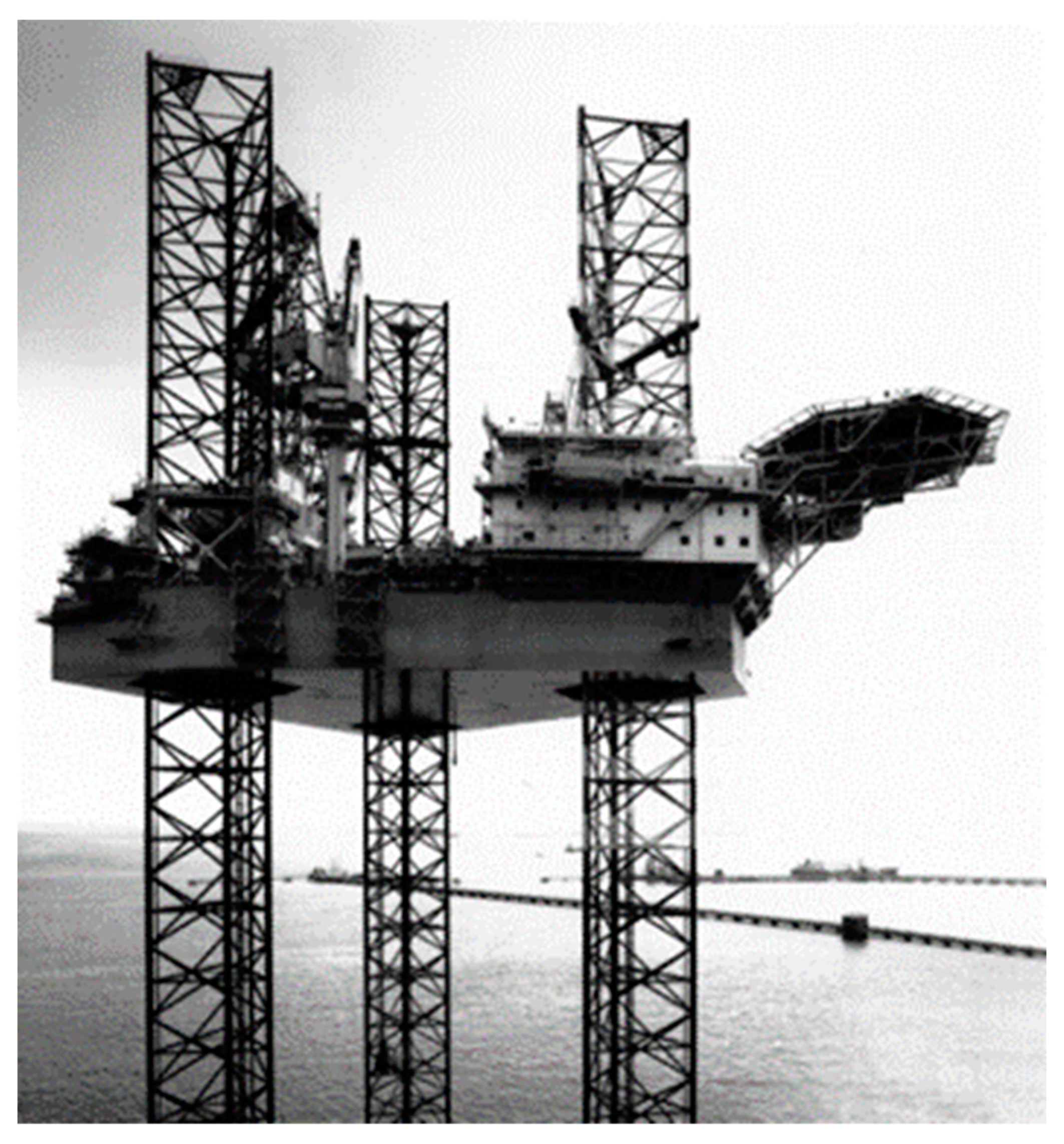
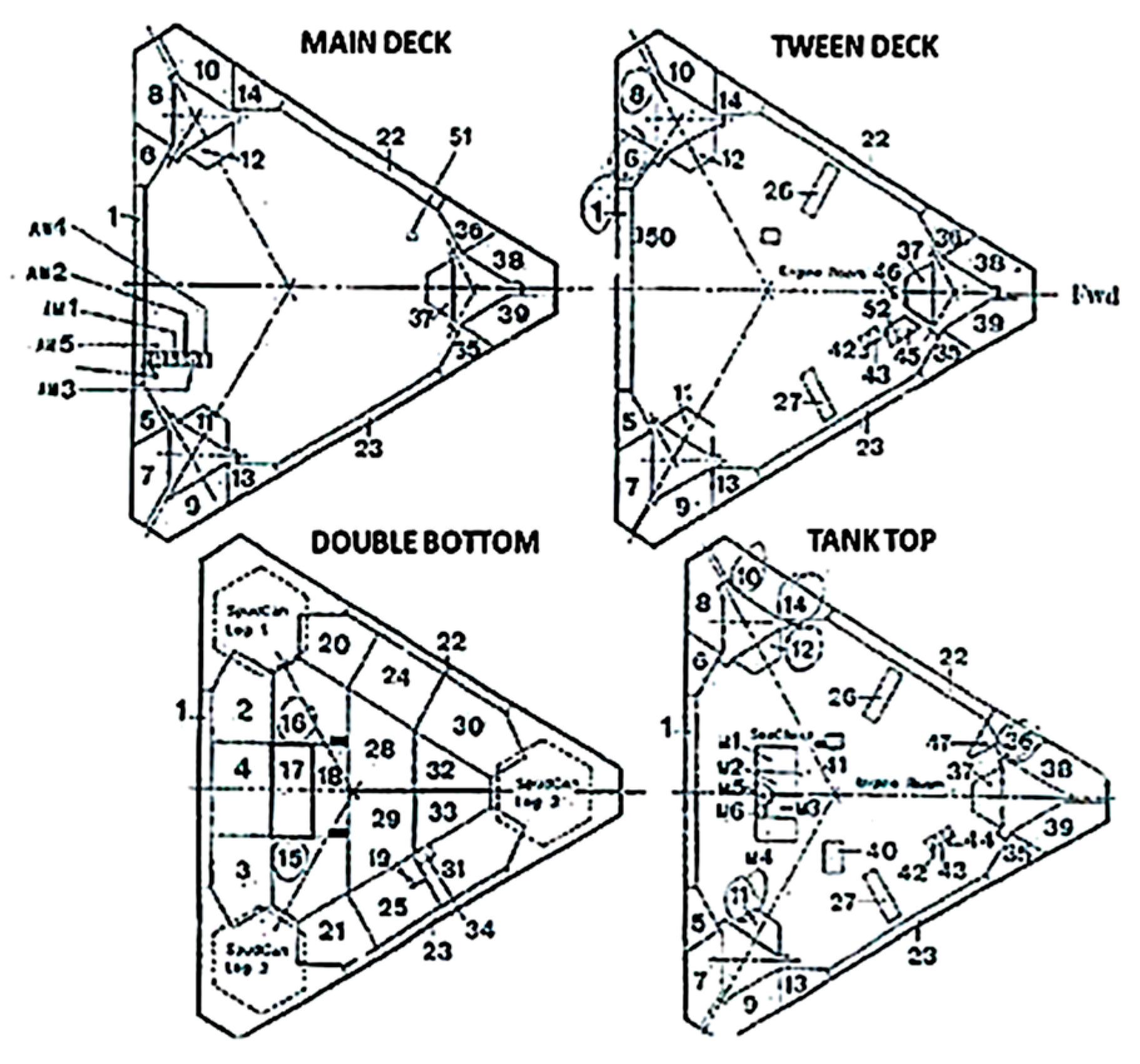
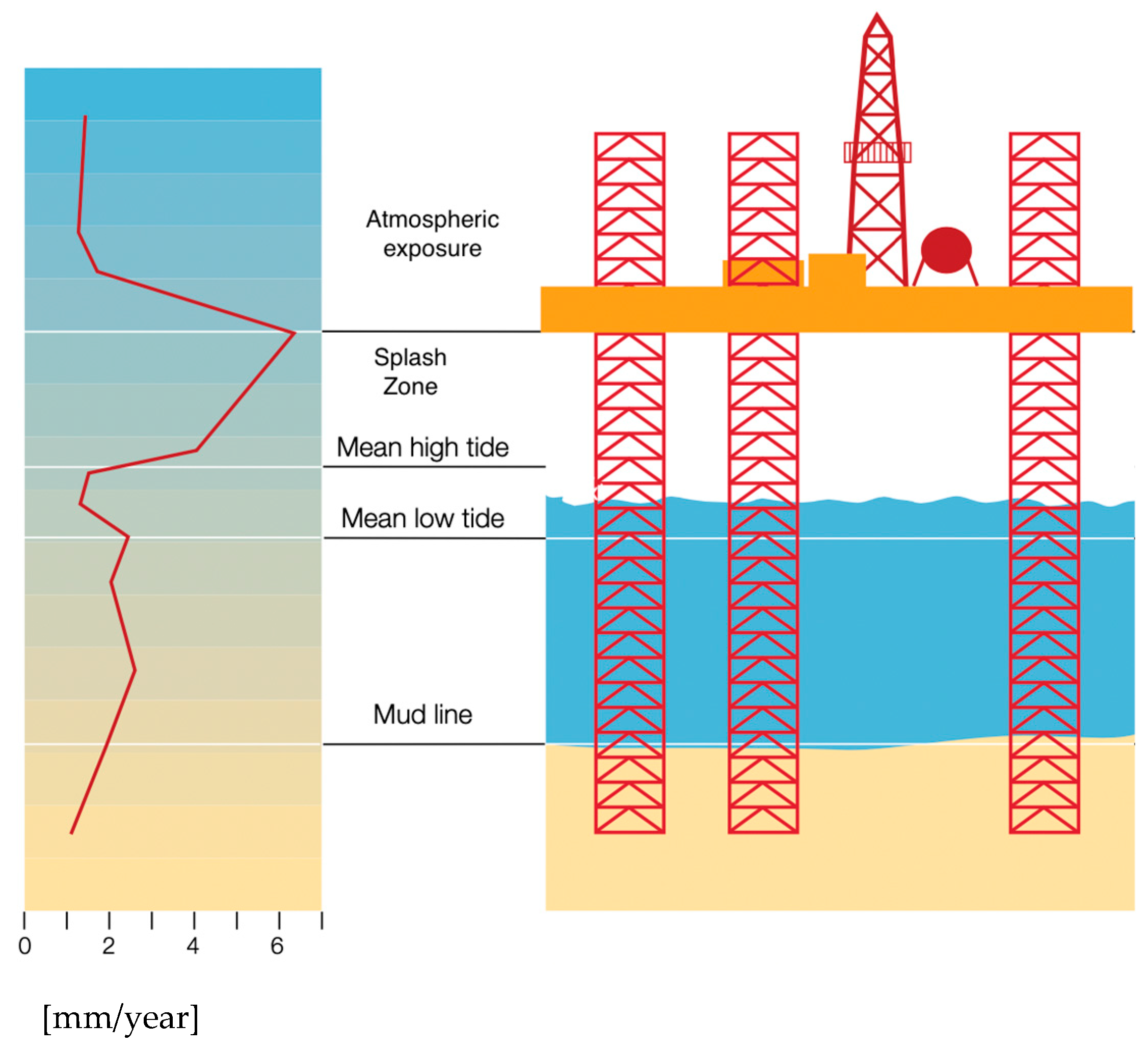


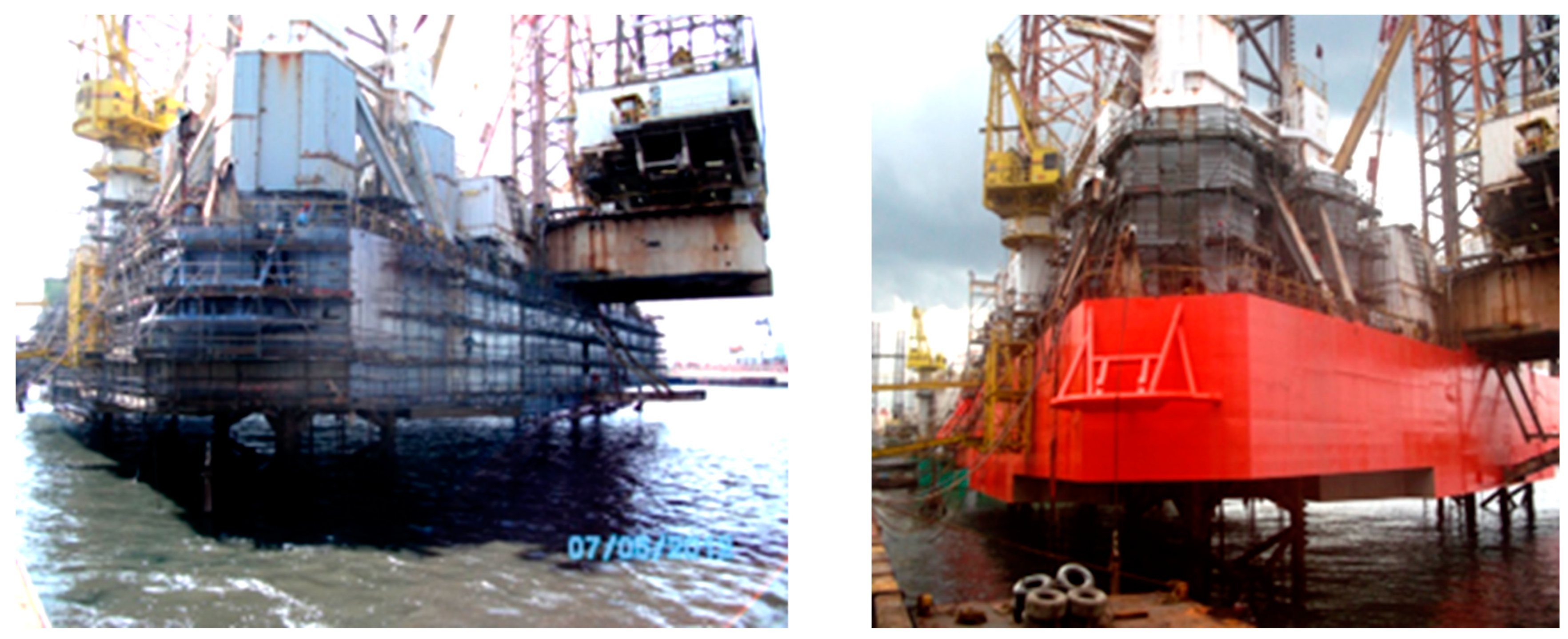
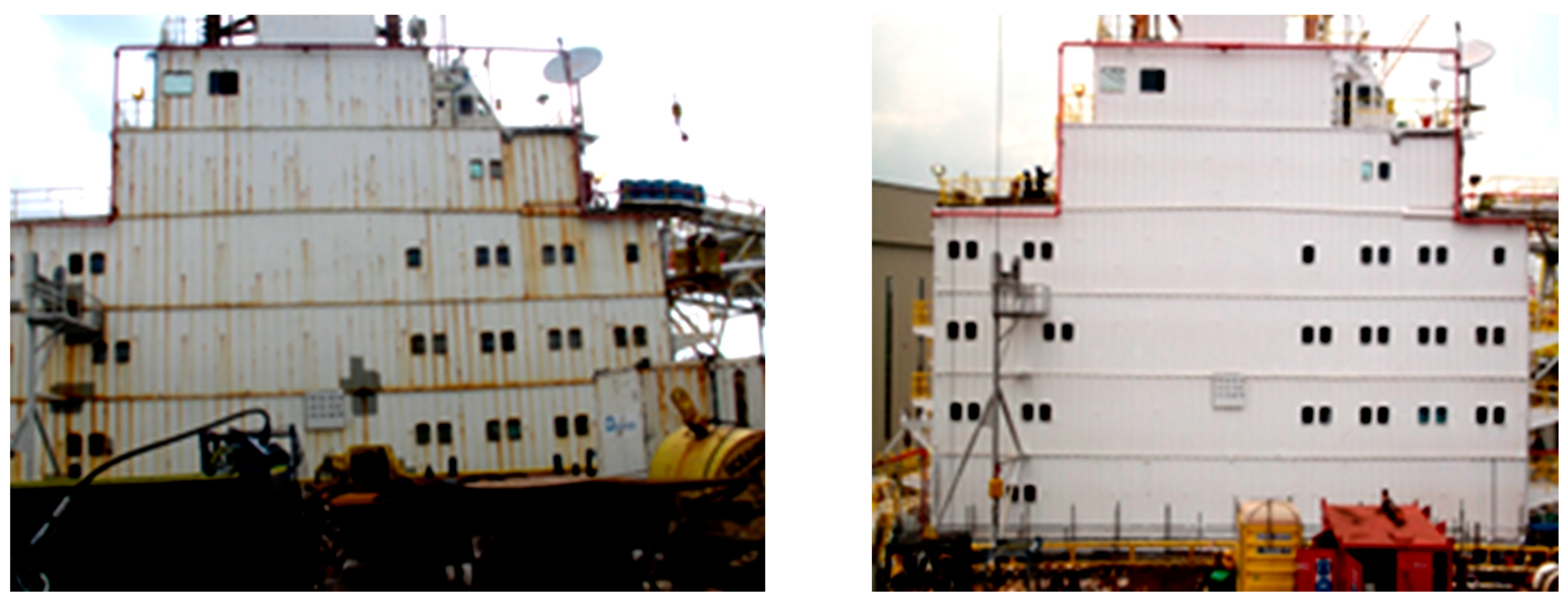
| Structural Zone | Corrosion Rate (mm/Year) | Structural Importance | Inspection Difficulty | Overall Risk Level |
|---|---|---|---|---|
| Splash Zone | 0.3–0.5 mm/year | High | Medium | High |
| Ballast Tanks | 0.2–0.4 mm/year | High | High | High |
| Hull Perimeter | 0.1–0.3 mm/year | Medium | Low | Medium |
| Legs and Spud Cans | 0.05–0.2 mm/year | Very High | High | High |
| Deck and Superstructure | <0.1 mm/year | Low | Low | Low |
| Location | Corrosion Type | Contributing Factors | Recommendations |
|---|---|---|---|
| Splash Zone | Pitting Corrosion | Cyclic wetting/drying, poor coating adhesion | Improved surface preparation and coating |
| Ballast Tanks | MIC | High humidity, inadequate ventilation | Enhanced ventilation and monitoring |
| Hull | Uniform Corrosion | Coating degradation over time | Periodic reapplication of high-performance coatings |
| Damage Type | Observations | Recommended Action | |
|---|---|---|---|
| Splash Zone | Pitting Corrosion | Material loss up to 6 mm | Steel renewal and re-coating |
| Pre-load Tank No. 8 | Microbiologically Influenced Corrosion (MIC) | Severe corrosion in stiffeners | Steel and coating renewals |
| Hull Perimeter | Uniform Corrosion | Widespread coating degradation | Steel plate replacement and re-coating |
| Legs and Spud Cans | Hydrogen-Assisted Cracking | Cracking at weld joints | Weld repairs and anode replacement |
Disclaimer/Publisher’s Note: The statements, opinions and data contained in all publications are solely those of the individual author(s) and contributor(s) and not of MDPI and/or the editor(s). MDPI and/or the editor(s) disclaim responsibility for any injury to people or property resulting from any ideas, methods, instructions or products referred to in the content. |
© 2025 by the authors. Licensee MDPI, Basel, Switzerland. This article is an open access article distributed under the terms and conditions of the Creative Commons Attribution (CC BY) license (https://creativecommons.org/licenses/by/4.0/).
Share and Cite
Babaei-Mahani, R.; Yasseri, S.; Lam, W.; Talebizadehsardari, P. A Case Study on the Corrosion of an Aging Jack-Up Drilling Rig. J. Mar. Sci. Eng. 2025, 13, 495. https://doi.org/10.3390/jmse13030495
Babaei-Mahani R, Yasseri S, Lam W, Talebizadehsardari P. A Case Study on the Corrosion of an Aging Jack-Up Drilling Rig. Journal of Marine Science and Engineering. 2025; 13(3):495. https://doi.org/10.3390/jmse13030495
Chicago/Turabian StyleBabaei-Mahani, Roohollah, Sirous Yasseri, Wayne Lam, and Pouyan Talebizadehsardari. 2025. "A Case Study on the Corrosion of an Aging Jack-Up Drilling Rig" Journal of Marine Science and Engineering 13, no. 3: 495. https://doi.org/10.3390/jmse13030495
APA StyleBabaei-Mahani, R., Yasseri, S., Lam, W., & Talebizadehsardari, P. (2025). A Case Study on the Corrosion of an Aging Jack-Up Drilling Rig. Journal of Marine Science and Engineering, 13(3), 495. https://doi.org/10.3390/jmse13030495








